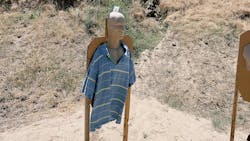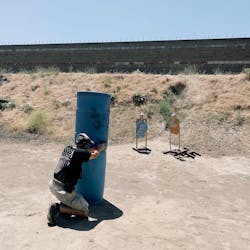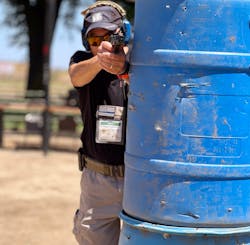Dimension: Training With 3D Targets
Over the past few months, we have explored training concepts like Shooting Rhythm, Training with Snap Caps, and shooting and operating One Handed. If there’s anything we have gained from these conversations, it’s the fact that we need to train regularly and and we need to “mix it up” a little.
This article appeared in the September/October issue of OFFICER Magazine. Click Here to subscribe to OFFICER Magazine.
It’s pretty common for law enforcement agencies to have a range of their own, or at least a shared facility through something like an MOU where training can take place. However, the likelihood of this range having motorized or automated targets is very low. In fact, many agencies train regularly on “square” ranges and two dimensional targets.What kinds of strategies can be used to mix it up a little? One thing that changes training dynamics is adding 3D targets. Using simple three-dimensional targets, three things change: Force Decision Making, Shooter Confidence, and Target Focus.
For this article, I used Birchwood Casey 3D Torso Targets. These are molded relief targets made of recycled material. They are as light as cardboard, and have enough structural integrity to hold up to a lot of hits. These targets are 21.5” H X 14” W X 4.7” D, and are very cost effective. The only thing you need to know is that they take up a little more storage space, and they have the same constraints as regular paper targets, like storing them in a dry place.
Since they are basically recycled paper, one can add extra realism to Birchwood Casey 3D Torso Targets, like clothing and drawn facial expressions. They can be hung like hanging moving targets, and stapled to a backing. They are incredibly light, allowing for quick range set up, since it’s easy to carry 30 of them at a time.
They can be hung like hanging moving targets, and stapled to a backing. They are incredibly light, allowing for quick range set up, since it’s easy to carry 30 of them at a time.Force Decision Making
3D targets add a psychological aspect to an officer’s training, depending on how the actual training scenario is treated. For example, the training could include instructions to “Pay attention to the orientation of the suspect. If they are not facing you, and engaging you, use other means than a firearm, until a firearm is necessary.” As the scenario moves on, the interaction can change. “She is now raising the muzzle of her gun at another officer. Proceed.”
Like any other training, the memorialized dialogue is just as important as the shooting portion of the training. That is, you need to record that your agency toggled between shoot/no shoot scenarios, and likely included a qualification. When I’m training with these targets, it is easier to see the hits and potential effect of these hits
In several controlled training studies, researchers found that experiencing the fight-or-flight phenomenon can distort perception of the threat and the overall incident. Critical incident perception distortion is not uncommon, and we can’t overlook the fact that moderate SNS (sympathetic nervous system) arousal can actually improve alertness, and vigilance. However, gross stimulation can add to the perception distortion. (Andersen & Gustafsberg, 2016)
In the “psychology of the moment”, the officer’s perception that “things are out of control” can increase the distortion. My guess is that training could mitigate the perception, considering that training increases the perception of control. Using 3D targets will likely help the officer’s stress level while in actual incidents, at least the training can’t hurt.
Increase Shooter Confidence
Recently, the Villa Rica Police Department in Georgia faced some backlash on social networking for using realistic targets that were photographs depicting real human beings. Apparently, the targets included an image of a black man as a target during a firearms safety class for civilians. The full set of this style of target includes depictions of all different kinds of people, representing many ethnicities and genders. The truth is, it is important for agencies to include a good variety of targets for their training, so that all kinds of target scenarios are represented.
Including a variety of targets increases the mental template for good force decision making. If the officer is constantly introduced to different targets and target scenarios, they connect shooting with decision making, which increases shooter confidence.
With three-dimensional targets, trainers can change the orientation of the target, such as facing it 45 degrees in relation to the firing lane, and require verbal commands before engaging. Based on the scenario, the officer can be guided through the scenario, which can include force decision making. For example, if the officer was slicing the pie through a simulated hallway, and the target is bladed in relation to the officer’s axis of advance, one response would be verbal commands and radio communication to dispatch and other units. This is something that is simulated on the range, and clearly documented in the training record.
What I found in training was the increase in confidence level of shooters when the Birchwood Casey 3D Torso Targets are part of the scenario. Students learn where and how to engage these targets quickly, even if they are completely bladed on the range. In “real life” there are few times when an officer is presented an ideal view of the threat. Adding the challenge of dimension is a confidence booster.Target Focus
One of the drills I use in regular instruction is the el Presidente. For those unfamiliar, the great Col. Jeff Cooper used this drill regularly. The shooter stands at the 10-yard line facing away from the targets. The range setup consists of three torso targets set about shoulder width apart. On the threat command, the shooter turns, draws and fires two rounds into the A zone (center mass) of each target, then reloads and repeats the pattern. A completed course will have four hits in each target
When I have students do this drill, there is something everyone has in common, including me. If we don’t train this one regularly, we tend to shoot toward the outside of the targets, on the outer targets. That is, when engaging the target on the left, shooters will tend to shoot to the left of center.
Using a three-dimensional target changes this drill. After shooting flat targets, three-dimensional ones encourage the shooter to place shots differently. Otherwise, the shots that land on the target could potentially miss, or fail to interrupt the threat.
Using the Birchwood Casey targets regularly causes the shooter to place their shot based on the orientation of the target. The added dimension re-routes the focus to the threat stopping potential, rather than the goal of hitting the target
Run the el Presidente in its conventional manner, but turn each target on its axis 45 degrees to the right or left, arbitrarily. It is ok if shooters slow down a little to engage. Remember, the goal of this drill is accurate fire over speed.
Once the el Presidente has been run a few times, go to “headshots only”. This is quite a challenge, and I have been known to miss, or deliver only a “grazing shot” a few times.
The other 3D training that will help shooters is the opportunity to add distance, from 25 to 50 yards, to their regimen. As the shooter moves away from the target, tiny adjustments make large changes in the critical impact area.
A step further
If your agency is able, I recommend learning to shoot uphill and downhill with 3D targets. One thing that I do is tilt the targets towards and away from the shooter by shoving things under the base. Add time constraints. Vary the distance. Above all, keep training.
Andersen, J. P., & Gustafsberg, H. (2016). A Training Method to Improve Police Use of Force Decision Making: A Randomized Controlled Trial. SAGE Open, 6(2). https://doi.org/10.1177/2158244016638708
About the Author

Officer Lindsey Bertomen (ret.), Contributing Editor
Lindsey Bertomen is a retired police officer and retired military small arms trainer. He teaches criminal justice at Hartnell College in Salinas, California, where serves as a POST administrator and firearms instructor. He also teaches civilian firearms classes, enjoys fly fishing, martial arts, and mountain biking. His articles have appeared in print and online for over two decades.



